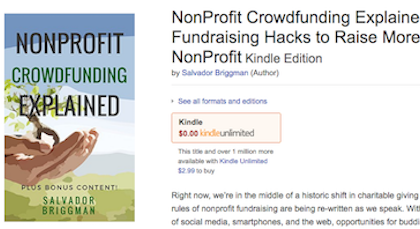Make the Pitch Scannable
Use headlines appropriately
There’s a reason that textbooks, newspaper articles, blogs, and magazines use headlines to separate blocks of text. It makes it much easier to scan through the content and pick out sections that are relevant to you. It seems like a no-brainer, but many campaigns I see read like long essays. Make it easy for people to go through the elements of the pitch with descriptive and eye-catching titles so that they don’t look at long blocks of text and close the browser window.
Short and point-driven paragraphs win out
Ideally, the first sentence of every paragraph should encompass the primary point you are trying to make. Each sentence following the first sentence should support or elaborate on this point. When you are finished with this point and would like to introduce a new topic (or expand on your topic with supporting points), a new paragraph should be created.
For example, this sentence and new paragraph would be a supporter to my previous paragraph and by making it a new block of text, it’s easier on the eyes and makes the pitch much more scannable.
Bolding, Links, and Italics are your friend
You might not think it, but when people are scanning an article or pitch, their eyes really do gravitate towards bolded words, links, and italics. Use these tools to convey tone or emotion with your pitch.
Break paragraphs up with images
As stated previously, long blocks of text aren’t just bad organization, but they really turn people off from whatever it is you are trying to communicate. Simply put, they are confusing and intimidating. Don’t give your readers a reason right off the bat to close their browser window! Break up your paragraphs with relevant images and illustrations.
Speak to the Reader, Don’t Orate
Emotion & passion trumps “professionalism”
Many people who come from a strong schooling background have this erroneous idea that it’s wrong to use “I” when writing for a reader or that terse, sterile sentences convey professionalism, and are therefore best.
While it’s true that for some audiences, extreme formal writing is required, the goal when running a Kickstarter project should be fostering empathy and connection with potential backers.
People love intense passion and in a big-business social media driven world, individuals want to connect with other individuals more than ever. The companies and people who win out are the ones that that can establish rapport or genuine one-to-many relationships with their customer base.
Show your backers how passionate you are. Share your vision.
“When dealing with people, let us remember we are not dealing with creatures of logic. We are dealing with creatures of emotion, creatures bristling with prejudices and motivated by pride and vanity.” Dale Carnegie
Put the backer first
If you are using the words “me,” “I,” “mine,” etc…You should only be doing it 10-20% of the time. During the rest of the time, the focus should be on YOU. How does the campaign benefit your backers? How will their life be awesome because of this product? Why will their contribution make this project a reality and ultimately change the world for the better?
Nit Picky Advice From William Strunk
Use definite, specific, concrete language
The definite and concrete is better than the abstract or general.
“He showed satisfaction as he took possession of his well-earned reward” is worse than “He grinned as he pocketed the coin.”
Use the active voice
“There were a great number of dead leaves lying on the ground” is worse than “Dead leaves covered the ground.”
“Steve is loved by Amy” is worse than “Amy loves Steve.”
For more information about the active voice, check out the blog Grammar Girl.
Read your pitch out loud
Writing is just another form of communication and your goal in composing a Kickstarter pitch should be to communicate your vision and idea to another human being (while getting them excited about it in the process). There’s no worse way to keep yourself at a distance than to use stilted language or incorrect grammar.
Read your entire pitch out loud. Are you using language and grammar that you would use if you were speaking to someone in person?
Sell the project as an experience
Finally, don’t think about the money. Don’t think about the money. Don’t think about how you will benefit from this crowdfunding “transaction.”
I’ve sold enough products and started enough businesses in the past to know that if you begin with thinking about how a relationship will benefit you, you are bound to fail (Though I still make this mistake sometimes!). You need to start from the beginning with how this project or opportunity will benefit someone else.
Why is this an awesome experience that they want to be a part of and will want to tell their friends about? You can bet that people who backed the Pebble Watch or the Ouya told their friends about it!
At the end of the day, you are not fostering a transaction where money passes from one party to another. You are trying to build a community around your project, mission, and possibly, life goal.




